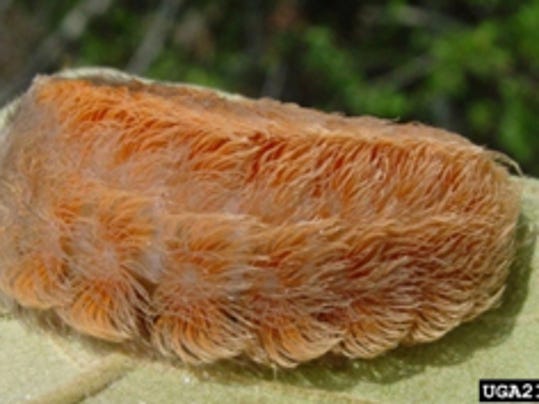 |
| Puss caterpillar - MDC |
An article in the
Springfield News-Leader had the interesting title
Venomous Caterpillars Rare in Missouri, but.... It concerned the puss caterpillar, said to be named because it resembles a soft cat. It is the larva of the
southern flannel moth, a species uncommonly found in southeastern Missouri but having its 15 minutes of fame due to an increase in the number of human encounters this year. This little ball of fuzz has been called the "most venomous caterpillar in the US."
First let me be clear. You are extremely unlikely to run into one in the Ozarks. The article was prompted by questions from residents from the Bootheel. Although it looks like an aerial view of Donald Trump's head, beneath the soft fuzzy exterior lie toxic spines that stick to your skin and cause pain greater than a bee sting, frequently radiating up an arm and lasting hours. If you're curious read more in this
National Geographic link.
We do encounter less toxic stinging caterpillars in Missouri and a few pictures of what not to touch might be helpful. The saddleback caterpillar above (
Acharia stimulea) is quite colorful and distinctive example. A good rule of thumb (or finger, hand, arm etc.) is avoid touching caterpillars that are hairy unless you know the species. An obvious example of harmless is everyone's favorite
weather forecaster, the wooly bear.
Most of the stinging caterpillars look threatening. If it looks like it would hurt, you are best to believe it. Common examples in Ozark species include the stinging rose caterpillar (
Parasa indetermina), buck moth caterpillar (
Hemileuca maia), and the Io moth caterpillar (
Automeris io).
 |
| Buck moth caterpillar - Donna |
Probably the Missouri caterpillar voted "Least Likely to Touch" would be the hag moth caterpillar (
Phobetron pithecium), also called the monkey slug. The common response would be somewhere between "what kind of creature is that?" and "Yuck!" Good protection, as it too has stinging hairs.
If you do come in painful contact with one of these, the first aid consists of duct tape or scotch tape
. According to
MDC Forest Entomologist Rob Lawrence:
"Stings from some venomous caterpillars can be quite painful, but not
deadly, according to Lawrence. Stings can be covered in scotch tape to
remove any remaining spines, and then washed thoroughly with soap and
water to clean the wound. Applying ice or baking soda may help reduce
the pain. Stings should be observed to ensure allergic
reactions don't occur."
Special thanks to all those who post their photographs to Bugguide,net and other sources using a Creative Commons License or otherwise permitting their use for educational purposes. Consider this when posting your photographs.






